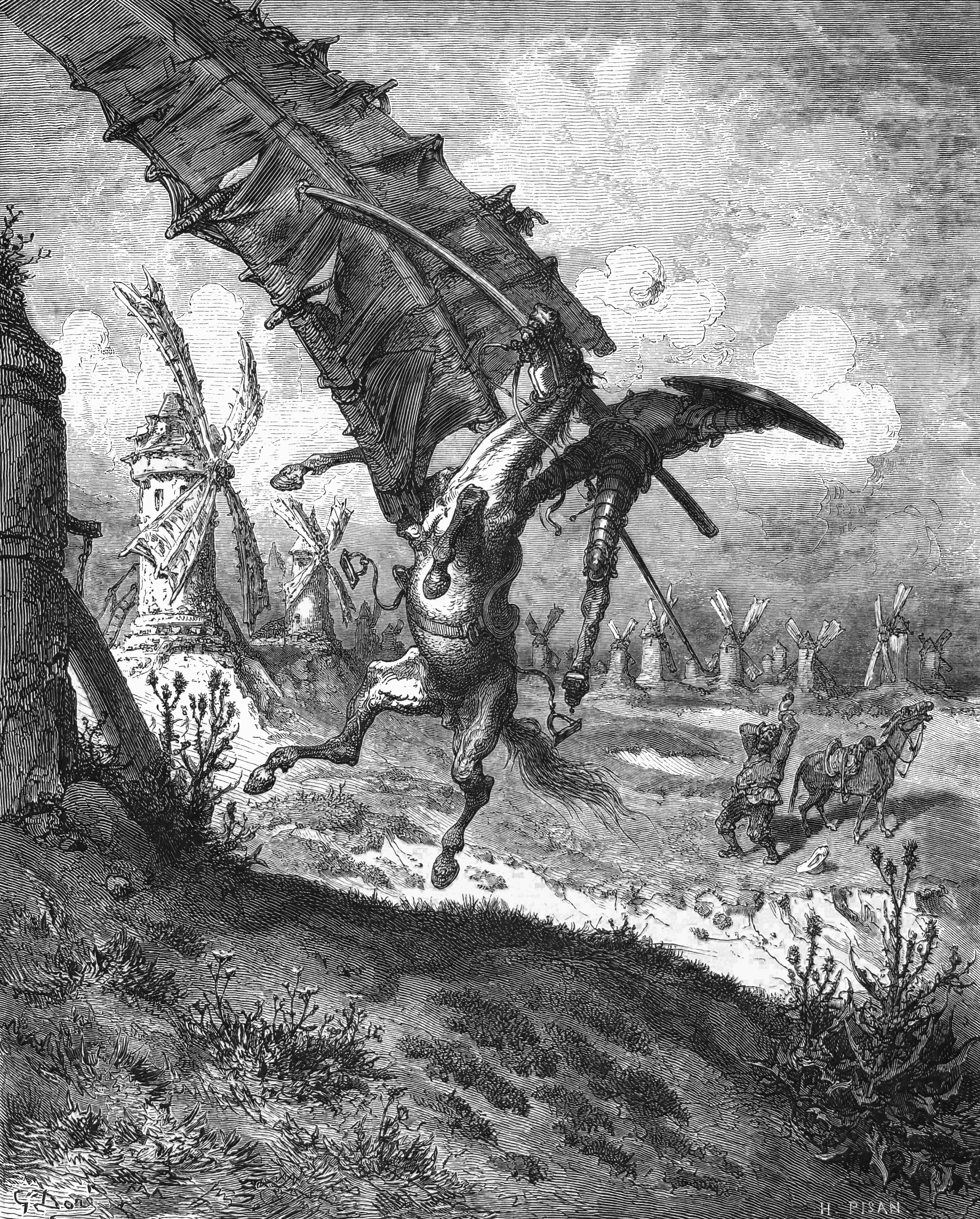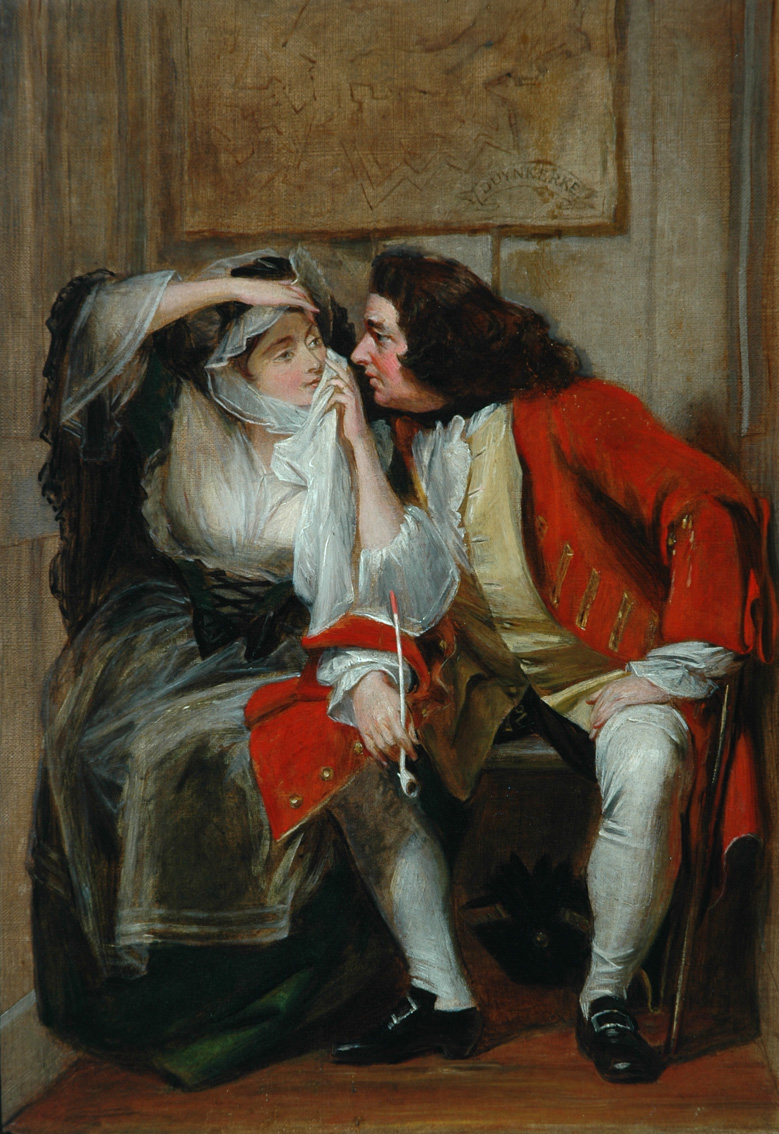|
Metafiction
Metafiction is a form of fiction which emphasises its own narrative structure in a way that continually reminds the audience that they are reading or viewing a fictional work. Metafiction is self-conscious about language, literary form, and story-telling, and works of metafiction directly or indirectly draw attention to their status as artifacts. Metafiction is frequently used as a form of parody or a tool to undermine literary conventions and explore the relationship between literature and reality, life, and art. Although metafiction is most commonly associated with postmodern literature that developed in the mid-20th century, its use can be traced back to much earlier works of fiction, such as ''The Canterbury Tales'' (Geoffrey Chaucer, 1387), ''Don Quixote'' (Miguel de Cervantes, 1605), ''The Life and Opinions of Tristram Shandy, Gentleman'' (Laurence Sterne, 1759), and '' Vanity Fair'' (William Makepeace Thackeray, 1847). Metafiction became particularly prominent in the 1960 ... [...More Info...] [...Related Items...] OR: [Wikipedia] [Google] [Baidu] |
Postmodern Literature
Postmodern literature is a form of literature that is characterized by the use of metafiction, unreliable narration, self-reflexivity, intertextuality, and which often thematizes both historical and political issues. This style of experimental literature emerged strongly in the United States in the 1960s through the writings of authors such as Kurt Vonnegut, Thomas Pynchon, William Gaddis, Philip K. Dick, Kathy Acker, and John Barth. Postmodernists often challenge authorities, which has been seen as a symptom of the fact that this style of literature first emerged in the context of political tendencies in the 1960s.Linda Hutcheon (1988) ''A Poetics of Postmodernism.'' London: Routledge, pp. 202-203. This inspiration is, among other things, seen through how postmodern literature is highly self-reflexive about the political issues it speaks to. Precursors to postmodern literature include Miguel de Cervantes’ ''Don Quixote'' (1605–1615), Laurence Sterne’s ''Tristram Shandy' ... [...More Info...] [...Related Items...] OR: [Wikipedia] [Google] [Baidu] |
The French Lieutenant's Woman
''The French Lieutenant's Woman'' is a 1969 postmodern historical fiction novel by John Fowles. The plot explores the fraught relationship of gentleman and amateur naturalist Charles Smithson and Sarah Woodruff, the former governess and independent woman with whom he falls in love. The novel builds on Fowles' authority in Victorian literature, both following and critiquing many of the conventions of period novels.Warburton 166. The book was the author's third, after ''The Collector'' (1963) and '' The Magus'' (1965). ''American Libraries'' magazine counted the novel among the "Notable Books of 1969". Subsequent to its initial popularity, publishers produced numerous editions and translated the novel into many languages; soon after the initial publication, the novel was also treated extensively by scholars. The novel remains popular, figuring in both public and academic conversations. In 2005 ''Time'' chose the book as one of the 100 best English-language novels since the mag ... [...More Info...] [...Related Items...] OR: [Wikipedia] [Google] [Baidu] |
Lost In The Funhouse
''Lost in the Funhouse'' (1968) is a short story collection by American author John Barth. The postmodern stories are extremely self-conscious and self-reflexive and are considered to exemplify metafiction. Though Barth's reputation rests mainly on his long novels, the stories "Night-Sea Journey", "Lost in the Funhouse", "Title" and "Life-Story" from ''Lost in the Funhouse'' are widely anthologized. The book appeared the year after the publication of his essay ''The Literature of Exhaustion'', in which Barth said that the traditional modes of realistic fiction had been used up, but that this exhaustion itself could be used to inspire a new generation of writers, citing Nabokov, Beckett, and especially Borges as exemplars of this new approach. ''Lost in the Funhouse'' took these ideas to an extreme, for which it was both praised and condemned by critics. Overview Each story can be considered complete in itself, and in fact several of them were published separately before being c ... [...More Info...] [...Related Items...] OR: [Wikipedia] [Google] [Baidu] |
John Barth
John Simmons Barth (; born May 27, 1930) is an American writer who is best known for his postmodern and metafictional fiction. His most highly regarded and influential works were published in the 1960s, and include ''The Sot-Weed Factor'', a satirical retelling of Maryland's colonial history, and ''Lost in the Funhouse'', a self-referential and experimental collection of short stories. Though Barth's work has been controversial among critics and readers, he was co-recipient of the National Book Award in 1973 for his novel ''Chimera'' with John Williams for ''Augustus''. Despite Barth's influence on postmodern literature in America, his influence and publicity have decreased since his novels were published. Life John Barth, called "Jack", was born in Cambridge, Maryland. He has an older brother, Bill, and a twin sister Jill. In 1947 he graduated from Cambridge High School, where he played drums and wrote for the school newspaper. He briefly studied "Elementary Theory and Adv ... [...More Info...] [...Related Items...] OR: [Wikipedia] [Google] [Baidu] |
The Brief Wondrous Life Of Oscar Wao
''The Brief Wondrous Life of Oscar Wao'' is a 2007 novel written by Dominican American author Junot Díaz. Although a work of fiction, the novel is set in New Jersey in the United States, where Díaz was raised, and it deals with the Dominican Republic's experience under dictator Rafael Trujillo. The book chronicles both the life of Oscar de León, an overweight Dominican boy growing up in Paterson, New Jersey, who is obsessed with science fiction and fantasy novels and with falling in love, as well as a curse that has plagued his family for generations. Narrated by multiple characters, the novel incorporates a significant amount of Spanglish and neologisms, as well as references to fantasy and science fiction books and films. Through its overarching theme of the ''fukú'' curse, it additionally contains elements of magic realism. It received highly positive reviews from critics, who praised Díaz's writing style and the multi-generational story. ''The Brief Wondrous Life of Os ... [...More Info...] [...Related Items...] OR: [Wikipedia] [Google] [Baidu] |
Kurt Vonnegut
Kurt Vonnegut Jr. (November 11, 1922 – April 11, 2007) was an American writer known for his satirical and darkly humorous novels. In a career spanning over 50 years, he published fourteen novels, three short-story collections, five plays, and five nonfiction works; further collections have been published after his death. Born and raised in Indianapolis, Vonnegut attended Cornell University but withdrew in January 1943 and enlisted in the US Army. As part of his training, he studied mechanical engineering at the Carnegie Institute of Technology (now Carnegie Mellon University) and the University of Tennessee. He was then deployed to Europe to fight in World War II and was captured by the Germans during the Battle of the Bulge. He was interned in Dresden, where he survived the Allied bombing of the city in a meat locker of the slaughterhouse where he was imprisoned. After the war, he married Jane Marie Cox, with whom he had three children. He adopted his nephews after his siste ... [...More Info...] [...Related Items...] OR: [Wikipedia] [Google] [Baidu] |
Don Quixote
is a Spanish epic novel by Miguel de Cervantes. Originally published in two parts, in 1605 and 1615, its full title is ''The Ingenious Gentleman Don Quixote of La Mancha'' or, in Spanish, (changing in Part 2 to ). A founding work of Western literature, it is often labelled as the first modern novel and one of the greatest works ever written. ''Don Quixote'' is also one of the most-translated books in the world. The plot revolves around the adventures of a member of the lowest nobility, an hidalgo from La Mancha named Alonso Quijano, who reads so many chivalric romances that he either loses or pretends to have lost his mind in order to become a knight-errant () to revive chivalry and serve his nation, under the name . He recruits a simple farmer, Sancho Panza, as his squire, who often employs a unique, earthy wit in dealing with Don Quixote's rhetorical monologues on knighthood, already considered old-fashioned at the time, and representing the most droll realism in contr ... [...More Info...] [...Related Items...] OR: [Wikipedia] [Google] [Baidu] |
Robert Coover
Robert Lowell Coover (born February 4, 1932) is an American novelist, short story writer, and T.B. Stowell Professor Emeritus in Literary Arts at Brown University. He is generally considered a writer of fabulation and metafiction. Background Coover was born in Charles City, Iowa. He attended Southern Illinois University Carbondale, received his B.A. in Slavic Studies from Indiana University Bloomington in 1953, then served in the United States Navy from 1953 to 1957, where he became a lieutenant. He received an M.A. in General Studies in the Humanities from the University of Chicago in 1965. In 1968, he signed the "Writers and Editors War Tax Protest" pledge, vowing to refuse tax payments in protest against the Vietnam War. Coover has served as a teacher or writer in residence at many universities. He taught at Brown University from 1981 to 2012. Coover's wife is the noted needlepoint artist Pilar Sans Coover. They have three children, including Sara Caldwell. Literary caree ... [...More Info...] [...Related Items...] OR: [Wikipedia] [Google] [Baidu] |
Slaughterhouse-Five
''Slaughterhouse-Five, or, The Children's Crusade: A Duty-Dance with Death'' is a 1969 semi-autobiographic science fiction-infused anti-war novel by Kurt Vonnegut. It follows the life and experiences of Billy Pilgrim, from his early years, to his time as an American soldier and chaplain's assistant during World War II, to the post-war years, with Billy occasionally traveling through time. The text centers on Billy's capture by the German Army and his survival of the Allied firebombing of Dresden as a prisoner of war, an experience which Vonnegut himself lived through as an American serviceman. The work has been called an example of "unmatched moral clarity"Powers, Kevin"The Moral Clarity of ‘Slaughterhouse-Five’ at 50" The New York Times, March 23, 2019, ''Sunday Book Review'', p. 13. and "one of the most enduring anti-war novels of all time". Plot The story is told in a non-linear order by an unreliable narrator (he begins the novel by telling the reader, "All of this happ ... [...More Info...] [...Related Items...] OR: [Wikipedia] [Google] [Baidu] |
Thomas Pynchon
Thomas Ruggles Pynchon Jr. ( , ; born May 8, 1937) is an American novelist noted for his dense and complex novels. His fiction and non-fiction writings encompass a vast array of subject matter, genres and themes, including history, music, science, and mathematics. For ''Gravity's Rainbow'', Pynchon won the 1973 U.S. National Book Award for Fiction."National Book Awards – 1974" . Retrieved 2012-03-29. (With essays by Casey Hicks and Chad Post from the Awards 60-year anniversary blog. The mock acceptance speech by Irwin Corey is not reprinted by NBF.) Hailing from |
The Life And Opinions Of Tristram Shandy, Gentleman
''The Life and Opinions of Tristram Shandy, Gentleman'', also known as ''Tristram Shandy'', is a novel by Laurence Sterne, inspired by ''Don Quixote''. It was published in nine volumes, the first two appearing in 1759, and seven others following over the next seven years (vols. 3 and 4, 1761; vols. 5 and 6, 1762; vols. 7 and 8, 1765; vol. 9, 1767). It purports to be a biography of the eponymous character. Its style is marked by digression, double entendre, and graphic devices. The first edition was printed by Ann Ward (printer), Ann Ward on Coney Street, York. Sterne had read widely, which is reflected in ''Tristram Shandy''. Many of his similes, for instance, are reminiscent of the works of the metaphysical poets of the 17th century, and the novel as a whole, with its focus on the problems of language, has constant regard for John Locke's theories in ''An Essay Concerning Human Understanding''. Arthur Schopenhauer called ''Tristram Shandy'' one of "the four immortal romances."A ... [...More Info...] [...Related Items...] OR: [Wikipedia] [Google] [Baidu] |
Junot Díaz
Junot Díaz (; born December 31, 1968) is a Dominican-American writer, creative writing professor at the Massachusetts Institute of Technology (MIT), and was fiction editor at ''Boston Review''. He also serves on the board of advisers for Freedom University, a volunteer organization in Georgia that provides post-secondary instruction to undocumented immigrants. Central to Díaz's work is the immigrant experience, particularly the Latino immigrant experience. Born in Santo Domingo, Dominican Republic, Díaz immigrated with his family to New Jersey when he was six years old. He earned a Bachelor of Arts degree from Rutgers University, and shortly after graduating created the character "Yunior", who served as narrator of several of his later books. After obtaining his MFA from Cornell University, Díaz published his first book, the 1995 short story collection ''Drown''. Diaz received the 2008 Pulitzer Prize for Fiction for his novel ''The Brief Wondrous Life of Oscar Wao'', and r ... [...More Info...] [...Related Items...] OR: [Wikipedia] [Google] [Baidu] |



.jpg)



